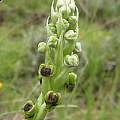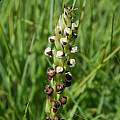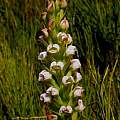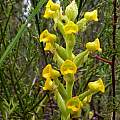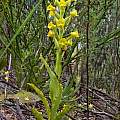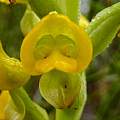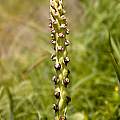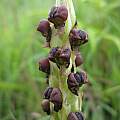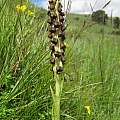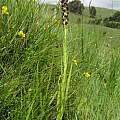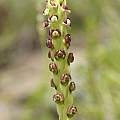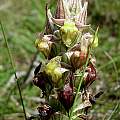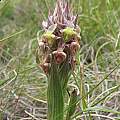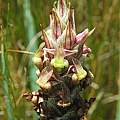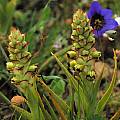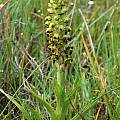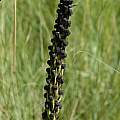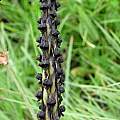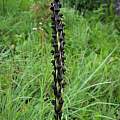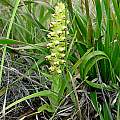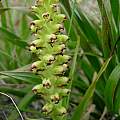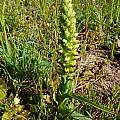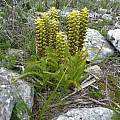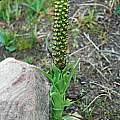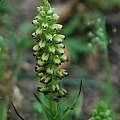Corycium is a tuberous geophytic genus in the Orchidaceae family of about 14 species from southern and tropical Africa. Some of them are common, but others are very rare. They grow in fynbos, grassland, and bushveld, flowering in spring or summer or after fire. Leaves are cauline, larger at the base. Flowers are small with a deep concave hood and a lip with a large appendage. The numerous flowers are pressed tightly to the stem.
Corycium alticola Parkman & Schelpe is found in damp mountain grassland from 1950 to 2400 meters. It is endemic to the Drakensberg and grows to 40 cm. It has large white sepals that turn black, pale green petals and a pale maroon oblong lip. Photos taken by Cameron McMaster and Mary Sue Ittner at Naude's Nek in the Eastern Cape.
Corycium carnosum (Lindl.) Rolfe is found mostly on sandstone slopes from the Cape Peninsula to the Eastern Cape. Growing to 55 cm with narrowly lanceolate leaves, this species has few to many green and pink flowers in a dense raceme. The whitish pink lip has two broad diverging lobes. It flowers October to January, after fire. Photo from the CD of Plants of the Klein Karoo courtesy of Jan and Anne Lise Schutte-Vlok.
Corycium crispum (Thunb.) Sw. has lance shaped leaves with crisped margins and grows to 40 cm tall, flowering September and October. The yellow flowers have green spurs. It grows in open sandy sites in Namaqualand, the Western Cape into the western Karoo. Photos taken near Clanwilliam by Cameron McMaster.
Corycium dracomontanum Parkman & Schelpe is found in grassland in the Eastern Cape. It has many flowers in a dense raceme and flowers November to March. It grows to 22 cm and is very difficult to tell apart from Corycium nigrescens, made more difficult by their growing in the same places. A hand lens may be necessary. Sepals are pale green or pinkish and the petals and lip green suffused purple, but flowers soon turn black. In this species the apex of the lip is variable, rotund to obovate and acute and the lip appendages bright green with side arms more or less oblong and facing sideways, not backwards. Photos 1-5 by Cameron McMaster taken at Mt. Thomas, Maclear, and Satansnek Pass in the Eastern Cape. Photo 6 taken by Christopher Whitehouse at Gaikas Kop.
Corycium flanaganii (Bolus) Kurzweil & H.P.Linder is a species found in Lesotho and the Eastern Cape. Photos taken by Cameron McMaster at Thomas River and Tiffendell and by Mary Sue Ittner at Naude's Nek in the Eastern Cape.
Corycium ingeanum E.G.H.Oliv. is endemic to the BokkeveldPlateau when it is found in gravelly clay in renosterveld, flowering in September. It has lance shaped leaves and has yellow- green flowers that are deeply cupped with a reddish black rim. Photos taken September 2006 near Nieuwoudtville of what I think is this species by Mary Sue Ittner. I suppose it could also be Corycium orobanchoides
Corycium nigrescens Sond. is a widespread orchid in southern Africa that grows in wet grassland and along vlei margins, often in large colonies. It is very difficult to tell apart from Corycium dracomontanum, made more difficult by their growing in the same places. Sepals are pale green, quickly turning dry and black; petals are purple-black to black. The lip is purplish green and the side arms of the lip appendage are tapering, pointing backwards. The apex of the lip is usually notched and upturned. This species grows to 55 cm. Photos taken by Bob Rutemoeller and Cameron McMaster at Naude's Nek and Satansnek Pass in the Eastern Cape, January 2010.
Corycium orobanchoides (L.f.) Sw. is found on sandy flats. It grows to 42 cm with many lance shape leaves barred purple-red on the lower leaves and many yellow-green flowers with purplish-brown tips. Flowers are in a dense raceme and unpleasantly scented. It is widespread in the winter rainfall Cape Province and blooms September to October. The first two photos were taken by Cameron McMaster near Caledon in the Overberg, the third near Darling on the west coast of the southwestern Cape, and the fourth near Jacobsbaii. The last two photos were taken by Mary Sue Ittner in the Ramskop Nature Reserve in Clanwilliam. It wasn't identified to the species level, but I think it is this species.
